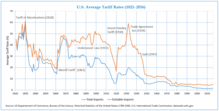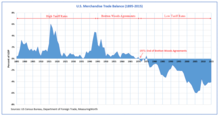Tariff
This term was introduced to the Latin-speaking world through contact with the Turks and derives from the Ottoman Turkish: تعرفه, romanized: taʿrife, lit.'notification; description; definition; announcement; assertion; inventory of fees to be paid' which is the verbal noun of Arabic: عرف, romanized: ʿarafa, lit.The Corn Acts had been passed in 1815 to restrict wheat imports and to guarantee the incomes of British farmers; their repeal devastated Britain's old rural economy, but began to mitigate the effects of the Great Famine in Ireland.[23] In response to the Great Depression, Britain abandoned free trade in 1932, recognizing that it had lost production capacity to the United States and Germany, which remained protectionist.Many of the great American economists of the time, until the last quarter of the 19th century, were strong advocates of industrial protection: Daniel Raymond who influenced Friedrich List, Mathew Carey and his son Henry, who was one of Lincoln's economic advisers.[28][29] In Report on Manufactures, considered the first text to express modern protectionist theory, Alexander Hamilton argued that if a country wished to develop a new activity on its soil, it would have to temporarily protect it.[30] Hamilton argued that despite an initial "increase of price" caused by regulations that control foreign competition, once a "domestic manufacture has attained to perfection... it invariably becomes cheaper.[31] In this report, Hamilton also proposed export bans on major raw materials, tariff reductions on industrial inputs, pricing and patenting of inventions, regulation of product standards and development of financial and transportation infrastructure.Hamilton's arguments shaped the pattern of American economic policy until the end of World War II, and his program created the conditions for rapid industrial development.[28][31] Britain initially did not want to industrialise the American colonies, and implemented policies to that effect (for example, banning high value-added manufacturing activities).[22] Between 1792 and the war with Britain in 1812, the average tariff level remained around 12.5%, which was too low to encourage consumers to buy domestic products and thus support emerging American industries.Abraham Lincoln was a protectionist like Henry Clay of the Whig Party, who advocated the "American system" based on infrastructure development and protectionism.Once elected, Lincoln implemented a 44-percent tariff during the Civil War—in part to pay for railroad subsidies and for the war effort, and to protect favored industries.[22] In 1896, the Republican Party platform pledged to "renew and emphasize our allegiance to the policy of protection, as the bulwark of American industrial independence, and the foundation of development and prosperity.[39] A review by the Economist of Irwin's 2017 book Clashing over Commerce: A History of US Trade Policy notes:[39]Political dynamics would lead people to see a link between tariffs and the economic cycle that was not there.Mr Irwin also methodically debunks the idea that protectionism made America a great industrial power, a notion believed by some to offer lessons for developing countries today.But American growth during its protectionist period was more to do with its abundant resources and openness to people and ideas.The Economist Ha-Joon Chang argues, on the contrary, that the United States developed and rose to the top of the global economic hierarchy by adopting protectionism.In his view, the protectionist period corresponded to the golden age of American industry, when US economic performance outstripped that of the rest of the world.[43] As of 2011, Milton Friedman held the opinion that the tariffs of 1930 caused harm but were not responsible by themselves for the Great Depression, which instead he blamed the lack of sufficient action on the part of the Federal Reserve.[44][page needed] According to William J. Bernstein, most economic historians now believe that only a fraction of the GDP loss worldwide and in the U.S. resulted from tariff wars.The bulk of the contraction of trade occurred between January 1930 and July 1932, that is, before the introduction of protectionist measures, even self-sufficient, in some countries, with the exception of those applied in the United States in the summer of 1930, but with very limited negative effects.A study by the National Bureau of Economic Research highlights the predominant influence of currency instability (which led to the international liquidity crisis[46]) and the sudden rise in transportation costs in the decline of trade during the 1930s.[48][49][50] States resorting to protectionism invoke unfair competition or dumping practices: According to the economists in favour of protecting industries, free trade would condemn developing countries to being nothing more than exporters of raw materials and importers of manufactured goods.[56] Some commentators argue that poor countries and regions that have succeeded in achieving strong and sustainable growth are those that have become mercantilists, not free traders: China, South Korea, Japan, Taiwan.[61] However, it has been argued that the models used are actually designed to maximise the positive effects of trade liberalisation, that they are characterised by the absence of taking into account the loss of income caused by the end of tariff barriers.Normative judgments often follow from these findings, namely that it may be disadvantageous for a country to artificially shield an industry from world markets and that it might be better to allow a collapse to take place.[71] A 2021 study found that across 151 countries over the period 1963–2014, "tariff increases are associated with persistent, economically and statistically significant declines in domestic output and productivity, as well as higher unemployment and inequality, real exchange rate appreciation, and insignificant changes to the trade balance.Finally, other countries must be expected to retaliate by imposing countervailing tariffs, a lose-lose situation that would lead to increased world-wide inflation.[96] The Liberal Party made a similar commitment, while independent candidate Nick Xenophon announced his intention to introduce tariff-based legislation as "a matter of urgency".[citation needed] Products may sometimes be imported into a free economic zone (or 'free port'), processed there, then re-exported without being subject to tariffs or duties.



Tariff (disambiguation)Taxationfiscal policyPoliciesGovernment revenueProperty tax equalizationTax revenueNon-tax revenueTax lawTax bracketFlat taxTax thresholdExemptionCreditDeductionTax shiftTax cutTax holidayTax amnestyTax advantageTax incentiveTax reformTax harmonizationTax competitionTax withholdingDouble taxationRepresentationUnionsMedical savings accountPrice effectExcess burdenTax incidenceLaffer curveOptimal taxTheoriesOptimal capital income taxationTax rateProgressiveRegressiveProportionalCollectionRevenue serviceRevenue stampTax assessmentTaxable incomeTax lienTax refundTax shieldTax residenceTax preparationTax investigationTax shelterTax collectorPrivate tax collectionTax farmingNoncomplianceTax avoidanceRepatriation tax avoidanceTax evasionTax resistanceDebtors' prisonSmugglingBlack marketUnreported employmentTax inversionTransfer mispricingBase erosion and profit shiftingDouble IrishDutch SandwichTax havensCorporate havensOffshore financial centresOffshore magic circleConduit and sink OFCsFinancial centresFinancial Secrecy IndexIreland as a tax havenIreland v. CommissionLeprechaun economicsLiechtenstein tax affairLuxembourg LeaksOffshore LeaksParadise PapersPanama PapersSwiss LeaksUnited States as a tax havenPanama as a tax havenDirectIndirectPer unitAd valoremAviationAirport improvementLandingSolidarityCapital gainsExpatriationConsumptionDepartureTelevisionTouristValue-addedDividendEnvironmental taxCarbonEco-tariffLandfillNatural resources consumptionSeveranceSteeringStumpageExciseAlcoholCigaretteSugary drinkTobaccoGeneralGeorgistGross receiptsHypothecatedIncomeInheritance (estate)Land valueLuxuryPayrollPigouvian